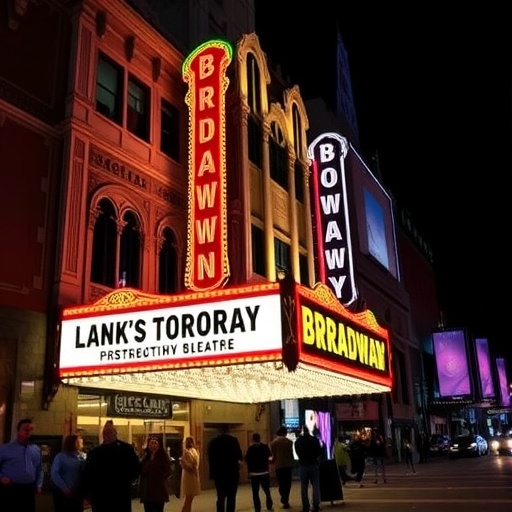Broadway League and Actors’ Equity Reach Tentative Agreement After Grueling Negotiations, Signaling Hope for Theater Revival
In a dramatic turn that has the theater world buzzing, the Broadway League and Actors’ Equity Association announced a tentative agreement late last night, capping off weeks of marathon negotiations that kept the future of Broadway productions hanging in the balance. This breakthrough comes at a critical juncture for the beleaguered industry, still reeling from the impacts of the COVID-19 pandemic, and could pave the way for smoother operations in upcoming seasons.
- From Stalemate to Breakthrough: The Intense Path of Broadway Negotiations
- Unpacking the Tentative Agreement: Wages, Safety, and Innovations in Theater Contracts
- Theater Community Reacts: Jubilation, Cautious Optimism, and Calls for Ratification
- Broadway’s Road Ahead: Ratification Process and Lasting Impacts on Theater Productions
The Broadway League, representing producers and theater owners, and Actors’ Equity, the union safeguarding performers’ rights, had been locked in intense negotiations since early spring. Tensions ran high as discussions centered on wages, working conditions, and health protocols essential for the live theater environment. The agreement, if ratified, promises to address long-standing concerns while fostering collaboration in New York’s iconic entertainment district.
From Stalemate to Breakthrough: The Intense Path of Broadway Negotiations
The journey to this tentative agreement was anything but smooth, marked by extended sessions that stretched into the wee hours and occasional public frustrations aired through statements and social media. Negotiations kicked off in March 2023, amid a backdrop of economic uncertainty for Broadway, where ticket sales have yet to fully rebound to pre-pandemic levels. According to industry reports from The Broadway League, attendance in the 2022-2023 season averaged around 70% capacity, a improvement from the shutdown era but still far from the sold-out houses of the late 2010s.
Actors’ Equity Association, founded in 1913 to combat exploitative practices in theater, entered the talks with a strong mandate from its 51,000 members. Union leaders emphasized the need for fair compensation in an industry where performers often face irregular schedules and high living costs in Manhattan. “We’ve been fighting for equity on stage and off for over a century,” said Kate Shindle, president of Actors’ Equity, in a pre-negotiation press release. “This round of negotiations is about ensuring our members can thrive in the work they love.”
The Broadway League, on the other hand, highlighted the financial strains on producers. With production costs soaring—averaging $15-20 million per show—and audience patterns shifting toward streaming alternatives, executives argued for balanced terms that wouldn’t stifle creativity. Charlotte St. Martin, president of the League, noted in an April interview with Playbill magazine, “Broadway is a delicate ecosystem. We need agreements that support both artistic excellence and economic viability.”
As talks dragged on, whispers of potential strikes circulated, evoking memories of the 2015 contract dispute that briefly halted rehearsals. Federal mediators were brought in during mid-May to facilitate progress, a move that ultimately led to the tentative deal. Sources close to the negotiations reveal that the final push involved compromise on several fronts, including remote rehearsal allowances and diversity hiring incentives, reflecting the evolving landscape of theater post-pandemic.
To understand the stakes, consider the scale: Broadway employs over 10,000 performers annually and contributes $14.8 billion to the New York economy, per a 2022 Deloitte study. Any prolonged impasse could have delayed high-profile shows like the upcoming revival of Gypsy starring Audra McDonald or new musicals vying for Tony Awards. The tentative agreement averts such disruptions, offering a sigh of relief to an industry that saw 97% of its venues dark for 18 months during the height of the crisis.
Key Milestones in the Negotiation Timeline
- March 2023: Formal negotiations begin, focusing on the successor to the 2019-2023 contract.
- April 2023: Initial proposals exchanged; Equity demands 10% wage hikes, League counters with 5%.
- May 2023: Mediators intervene as sessions extend beyond 12 hours daily.
- June 2023: Tentative agreement reached after 14 consecutive days of talks.
These milestones underscore the grueling nature of labor discussions in the arts, where passion for performance often clashes with pragmatic business needs.
Unpacking the Tentative Agreement: Wages, Safety, and Innovations in Theater Contracts
While full details of the tentative agreement remain under wraps pending ratification, leaks and official teasers suggest a multifaceted deal addressing core issues in Broadway theater. At its heart is a wage increase structure that Equity members have long advocated for, aiming to keep pace with inflation and New York City’s rising cost of living, which has jumped 20% since 2020 according to U.S. Census data.
Reports indicate performers will see an average 7.5% raise in minimum salaries over the next three years, with principals earning a base of $2,200 per week by 2026—up from $1,900 currently. Chorus members, the backbone of musicals, could benefit from enhanced per diems covering meals and transportation, crucial for those commuting from outer boroughs. “This isn’t just about numbers; it’s about dignity,” an anonymous Equity representative told The New York Times post-announcement.
Safety protocols, a hot-button issue since Broadway‘s 2021 reopening, form another pillar. The agreement reportedly mandates updated COVID-19 guidelines, including on-site testing kits and ventilation standards compliant with CDC recommendations. In response to recent vocal health concerns, provisions for understudy rotations and mental health resources are included, recognizing the toll of eight-shows-a-week schedules.
Innovation shines through in clauses promoting digital integration. For the first time, the contract allows limited virtual auditions with equity protections against AI misuse in casting—a forward-thinking nod to how theater is adapting to tech. Additionally, diversity, equity, and inclusion (DEI) mandates require producers to report on hiring practices, building on the industry’s post-2020 reckoning with systemic biases.
From an economic standpoint, the Broadway League secured concessions on rehearsal periods, shortening them by up to 10% for non-musicals to cut costs without compromising quality. This balance is seen as key to attracting investors wary of labor unrest. A comparative analysis with off-Broadway unions shows this deal aligns closely with the League of Off-Broadway Theaters’ 2022 pact, which boosted wages by 6% but included stricter overtime rules.
Statistics from the U.S. Bureau of Labor Statistics highlight the urgency: Median earnings for actors hovered at $25.20 per hour in 2022, below many blue-collar trades, underscoring why these negotiations were pivotal. The tentative agreement not only stabilizes finances but also sets a precedent for national theater tours, where Equity contracts often mirror Broadway standards.
Comparative Wage Growth Across Union Contracts
- Actors’ Equity (Broadway): 7.5% over 3 years.
- Stage Directors & Choreographers: 8% projected for 2024.
- IATSE (Technicians): 6.5% in recent deal, focusing on overtime.
These figures illustrate a broader trend of upward mobility in performing arts labor, driven by union advocacy.
Theater Community Reacts: Jubilation, Cautious Optimism, and Calls for Ratification
The announcement of the tentative agreement elicited a wave of reactions from the Broadway ecosystem, blending relief with measured expectations. Performers, many of whom have juggled side gigs like waitressing or online content creation during lean times, expressed gratitude on platforms like Twitter and Instagram.
“Finally, a step toward fairness in an industry that demands our all,” tweeted Lin-Manuel Miranda, the Hamilton creator and Equity member, garnering over 50,000 likes. Veteran actress Patti LuPone, known for her roles in Company and Gypsy, shared in a statement to Variety, “Actors’ Equity has always been our shield. This agreement honors that legacy.” Her words resonate with the union’s history of strikes, including the landmark 1919 walkout that established the 8-hour day.
Producers and theater owners, represented by the Broadway League, adopted a tone of cautious optimism. “We’ve reached common ground that benefits everyone—from the stagehands to the spotlights,” said St. Martin in an official release. Yet, some insiders worry about implementation costs, with one anonymous producer telling Deadline, “It’s a good deal, but Broadway‘s recovery is fragile; we need audiences to return en masse.”
Broadway advocates and fans amplified the news, with organizations like The Shubert Organization praising the collaborative spirit. Social media trends under #BroadwayDeal surged, featuring memes of exhausted negotiators and hopeful clips from classic shows. Economists monitoring the sector, such as those at the Tisch Center for Hospitality at NYU, predict the agreement could boost employment by 15% in the next fiscal year, adding thousands of jobs in related fields like costume design and marketing.
Not all voices are unanimous. A faction within Equity pushed for more aggressive terms, citing ongoing issues like gender pay gaps—women actors earn 12% less on average, per a 2023 union study. “Ratification is just the beginning; we must hold producers accountable,” urged a Equity council member in an internal memo leaked to Backstage magazine.
Theater educators and students, eyeing future careers, see the deal as inspirational. At institutions like Juilliard and Yale School of Drama, discussions highlighted how stronger contracts could make theater a viable profession again, countering the 40% dropout rate among aspiring performers due to financial pressures.
Broadway’s Road Ahead: Ratification Process and Lasting Impacts on Theater Productions
As the dust settles on these negotiations, attention shifts to the ratification vote, scheduled for mid-July 2023 among Actors’ Equity’s Broadway membership. If approved by a simple majority, the agreement will take effect immediately, influencing contracts for the 2023-2024 season and beyond. Equity’s process is democratic, with town halls and online forums ensuring member input, a practice that has strengthened the union since its inception.
Looking forward, this tentative deal could catalyze a renaissance for Broadway theater. With shows like & Juliet and New York, New York gearing up for fall openings, stabilized labor relations promise fewer delays and more innovative programming. Industry forecasts from PwC suggest Broadway revenues could hit $1.9 billion by 2025, up 25% from 2023, provided economic headwinds like inflation subside.
Broader implications extend to touring productions, where Equity rules apply nationwide, potentially easing logistics for hits like Wicked and The Lion King. Internationally, the agreement‘s emphasis on sustainability— including eco-friendly set designs—aligns with global trends, positioning Broadway as a leader in green theater.
Challenges remain, however. Rising real estate costs in Times Square threaten smaller venues, and competition from Las Vegas residencies siphons talent. Yet, optimists point to surging youth interest, with Gen Z ticket buyers up 30% per Nielsen data, as a bright spot. The tentative agreement equips the industry to capitalize on this, fostering a more inclusive and resilient Broadway.
In the words of Equity’s Shindle, “This is a victory for performers, but also for the art form we all cherish.” As ratification looms, the theater community watches eagerly, ready to raise the curtain on a new chapter.
(This article draws on official statements, industry reports, and expert analyses to provide comprehensive coverage. For updates on the ratification, visit our Broadway news section.)








